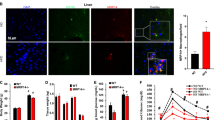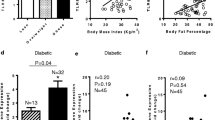Abstract
Aims/hypothesis
Obesity-induced inflammation is initiated by the recruitment of macrophages into adipose tissue. The recruited macrophages, called adipose tissue macrophages, secrete several proinflammatory cytokines that cause low-grade systemic inflammation and insulin resistance. The aim of this study was to find macrophage-recruiting factors that are thought to provide a crucial connection between obesity and insulin resistance.
Methods
We used chemotaxis assay, reverse phase HPLC and tandem MS analysis to find chemotactic factors from adipocytes. The expression of chemokines and macrophage markers was evaluated by quantitative RT-PCR, immunohistochemistry and FACS analysis.
Results
We report our finding that the chemokine (C-X-C motif) ligand 12 (CXCL12, also known as stromal cell-derived factor 1), identified from 3T3-L1 adipocyte conditioned medium, induces monocyte migration via its receptor chemokine (C-X-C motif) receptor 4 (CXCR4). Diet-induced obese mice demonstrated a robust increase of CXCL12 expression in white adipose tissue (WAT). Treatment of obese mice with a CXCR4 antagonist reduced macrophage accumulation and production of proinflammatory cytokines in WAT, and improved systemic insulin sensitivity.
Conclusions/interpretation
In this study we found that CXCL12 is an adipocyte-derived chemotactic factor that recruits macrophages, and that it is a required factor for the establishment of obesity-induced adipose tissue inflammation and systemic insulin resistance.





Similar content being viewed by others
Abbreviations
- ATM:
-
Adipose tissue macrophages
- CCL2:
-
Chemokine (C-C motif) ligand 2
- CCR2:
-
Chemokine (C-C motif) receptor 2
- CLS:
-
Crown-like structures
- CM:
-
Conditioned medium
- CXCL12:
-
Chemokine (C-X-C motif) ligand 12
- CXCR4:
-
Chemokine (C-X-C motif) receptor 4
- DIO:
-
Diet-induced obese
- HFD:
-
High-fat diet
- KO:
-
Knockout
- MCP1:
-
Monocyte chemoattractant protein 1
- MIF:
-
Macrophage migration factor
- MTT:
-
3-(4,5-Dimethylthiazol-2-yl)-2,5-diphenyltetrazolium bromide
- NCD:
-
Normal chow diet
- RP:
-
Reverse phase
- SCX:
-
Strong cation-exchange
- SDF1:
-
Stromal cell-derived factor 1
- SVC:
-
Stromal vascular cells
- SVF:
-
Stromal vascular fraction
- WAT:
-
White adipose tissue
References
Hotamisligil GS (2006) Inflammation and metabolic disorders. Nature 444:860–867
Xu H, Barnes GT, Yang Q et al (2003) Chronic inflammation in fat plays a crucial role in the development of obesity-related insulin resistance. J Clin Investig 112:1821–1830
Weisberg SP, McCann D, Desai M, Rosenbaum M, Leibel RL, Ferrante AW Jr (2003) Obesity is associated with macrophage accumulation in adipose tissue. J Clin Investig 112:1796–1808
Sun S, Ji Y, Kersten S, Qi L (2012) Mechanisms of inflammatory responses in obese adipose tissue. Annu Rev Nutr 32:261–286
Osborn O, Olefsky JM (2012) The cellular and signaling networks linking the immune system and metabolism in disease. Nat Med 18:363–374
Solinas G, Vilcu C, Neels JG et al (2007) JNK1 in hematopoietically derived cells contributes to diet-induced inflammation and insulin resistance without affecting obesity. Cell Metab 6:386–397
Han MS, Jung DY, Morel C et al (2013) JNK expression by macrophages promotes obesity-induced insulin resistance and inflammation. Science 339:218–222
Patsouris D, Li PP, Thapar D, Chapman J, Olefsky JM, Neels JG (2008) Ablation of CD11c-positive cells normalizes insulin sensitivity in obese insulin resistant animals. Cell Metab 8:301–309
Chawla A, Nguyen KD, Goh YP (2011) Macrophage-mediated inflammation in metabolic disease. Nat Rev Immunol 11:738–749
Kanda H, Tateya S, Tamori Y et al (2006) MCP-1 contributes to macrophage infiltration into adipose tissue, insulin resistance, and hepatic steatosis in obesity. J Clin Investig 116:1494–1505
Weisberg SP, Hunter D, Huber R et al (2006) CCR2 modulates inflammatory and metabolic effects of high-fat feeding. J Clin Investig 116:115–124
Inouye KE, Shi H, Howard JK et al (2007) Absence of CC chemokine ligand 2 does not limit obesity-associated infiltration of macrophages into adipose tissue. Diabetes 56:2242–2250
Kirk EA, Sagawa ZK, McDonald TO, O’Brien KD, Heinecke JW (2008) Monocyte chemoattractant protein deficiency fails to restrain macrophage infiltration into adipose tissue [corrected]. Diabetes 57:1254–1261
Zella D, Barabitskaja O, Burns JM et al (1998) Interferon-gamma increases expression of chemokine receptors CCR1, CCR3, and CCR5, but not CXCR4 in monocytoid U937 cells. Blood 91:4444–4450
Zella D, Barabitskaja O, Casareto L et al (1999) Recombinant IFN-alpha (2b) increases the expression of apoptosis receptor CD95 and chemokine receptors CCR1 and CCR3 in monocytoid cells. J Immunol 163:3169–3175
Kucia M, Ratajczak J, Ratajczak MZ (2005) Bone marrow as a source of circulating CXCR4+ tissue-committed stem cells. Biol Cell 97:133–146
Ceradini DJ, Kulkarni AR, Callaghan MJ et al (2004) Progenitor cell trafficking is regulated by hypoxic gradients through HIF-1 induction of SDF-1. Nat Med 10:858–864
De Clercq E, Yamamoto N, Pauwels R et al (1994) Highly potent and selective inhibition of human immunodeficiency virus by the bicyclam derivative JM3100. Antimicrob Agents Chemother 38:668–674
Olefsky JM, Glass CK (2010) Macrophages, inflammation, and insulin resistance. Annu Rev Physiol 72:219–246
Burger JA, Kipps TJ (2006) CXCR4: a key receptor in the crosstalk between tumor cells and their microenvironment. Blood 107:1761–1767
Lazarini F, Tham TN, Casanova P, Arenzana-Seisdedos F, Dubois-Dalcq M (2003) Role of the alpha-chemokine stromal cell-derived factor (SDF-1) in the developing and mature central nervous system. Glia 42:139–148
Nagasawa T, Hirota S, Tachibana K et al (1996) Defects of B cell lymphopoiesis and bone-marrow myelopoiesis in mice lacking the CXC chemokine PBSF/SDF-1. Nature 382:635–638
McGrath KE, Koniski AD, Maltby KM, McGann JK, Palis J (1999) Embryonic expression and function of the chemokine SDF-1 and its receptor, CXCR4. Dev Biol 213:442–456
Hill WD, Hess DC, Martin-Studdard A et al (2004) SDF-1 (CXCL12) is upregulated in the ischemic penumbra following stroke: association with bone marrow cell homing to injury. J Neuropathol Exp Neurol 63:84–96
Blogowski W, Serwin K, Budkowska M et al (2012) Clinical analysis of systemic and adipose tissue levels of selected hormones/adipokines and stromal-derived factor-1. J Biol Regul Homeost Agents 26:607–615
Hitchon C, Wong K, Ma G, Reed J, Lyttle D, El-Gabalawy H (2002) Hypoxia-induced production of stromal cell-derived factor 1 (CXCL12) and vascular endothelial growth factor by synovial fibroblasts. Arthritis Rheum 46:2587–2597
Tabatabai G, Frank B, Mohle R, Weller M, Wick W (2006) Irradiation and hypoxia promote homing of haematopoietic progenitor cells towards gliomas by TGF-beta-dependent HIF-1alpha-mediated induction of CXCL12. Brain J Neurol 129:2426–2435
Schober A (2008) Chemokines in vascular dysfunction and remodeling. Arterioscler Thromb Vasc Biol 28:1950–1959
Bernhagen J, Krohn R, Lue H et al (2007) MIF is a noncognate ligand of CXC chemokine receptors in inflammatory and atherogenic cell recruitment. Nat Med 13:587–596
Conine SJ, Cross JV (2014) MIF deficiency does not alter glucose homeostasis or adipose tissue inflammatory cell infiltrates during diet-induced obesity. Obesity 22:418–425
Balabanian K, Lagane B, Infantino S et al (2005) The chemokine SDF-1/CXCL12 binds to and signals through the orphan receptor RDC1 in T lymphocytes. J Biol Chem 280:35760–35766
Wang J, Shiozawa Y, Wang J et al (2008) The role of CXCR7/RDC1 as a chemokine receptor for CXCL12/SDF-1 in prostate cancer. J Biol Chem 283:4283–4294
Berahovich RD, Zabel BA, Penfold ME et al (2010) CXCR7 protein is not expressed on human or mouse leukocytes. J Immunol 185:5130–5139
Burns JM, Summers BC, Wang Y et al (2006) A novel chemokine receptor for SDF-1 and I-TAC involved in cell survival, cell adhesion, and tumor development. J Exp Med 203:2201–2213
Zabel BA, Wang Y, Lewen S et al (2009) Elucidation of CXCR7-mediated signaling events and inhibition of CXCR4-mediated tumor cell transendothelial migration by CXCR7 ligands. J Immunol 183:3204–3211
Sierro F, Biben C, Martinez-Munoz L et al (2007) Disrupted cardiac development but normal hematopoiesis in mice deficient in the second CXCL12/SDF-1 receptor, CXCR7. Proc Natl Acad Sci U S A 104:14759–14764
Lumeng CN, Bodzin JL, Saltiel AR (2007) Obesity induces a phenotypic switch in adipose tissue macrophage polarization. J Clin Investig 117:175–184
Lumeng CN, Deyoung SM, Bodzin JL, Saltiel AR (2007) Increased inflammatory properties of adipose tissue macrophages recruited during diet-induced obesity. Diabetes 56:16–23
Lumeng CN, DelProposto JB, Westcott DJ, Saltiel AR (2008) Phenotypic switching of adipose tissue macrophages with obesity is generated by spatiotemporal differences in macrophage subtypes. Diabetes 57:3239–3246
Sartipy P, Loskutoff DJ (2003) Monocyte chemoattractant protein 1 in obesity and insulin resistance. Proc Natl Acad Sci U S A 100:7265–7270
Kamei N, Tobe K, Suzuki R et al (2006) Overexpression of monocyte chemoattractant protein-1 in adipose tissues causes macrophage recruitment and insulin resistance. J Biol Chem 281:26602–26614
Gouwy M, Struyf S, Noppen S et al (2008) Synergy between coproduced CC and CXC chemokines in monocyte chemotaxis through receptor-mediated events. Mol Pharmacol 74:485–495
Funding
This work was supported by the National Research Foundation of Korea (NRF) grant funded by the Korea government (MEST) (No. 2013R1A2A1A03010110 and No.2010-0028684). This work was also funded by the GyeongSangBuk-Do Forestry Environment Research Institute.
Duality of interest
The authors declare that there is no duality of interest associated with this manuscript.
Contribution statement
DK, JK, KY, POB, PGS and SHR contributed to the conception and design of the study. DK, JK, JHY, JG, PS, SoP, AL, CPH, MSJ, YK and SeP contributed to the acquisition of data. DK, JK, and CPH contributed to data analysis. DK, JK, JHY, JG, MHJ and SHR contributed to the interpretation of data. DK drafted the manuscript and JK, JHY, JG, KY, PS, SoP, AL, CPH, MSJ, YK, SeP, MHJ, POB, PGS and SHR revised it. All authors approved the final version to be published. SHR is the guarantor of this work.
Author information
Authors and Affiliations
Corresponding author
Additional information
Dayea Kim and Jaeyoon Kim contributed equally to this study.
Electronic supplementary material
Below is the link to the electronic supplementary material.
ESM Methods
(PDF 159 kb)
ESM Fig. 1
(PDF 133 kb)
Rights and permissions
About this article
Cite this article
Kim, D., Kim, J., Yoon, J.H. et al. CXCL12 secreted from adipose tissue recruits macrophages and induces insulin resistance in mice. Diabetologia 57, 1456–1465 (2014). https://doi.org/10.1007/s00125-014-3237-5
Received:
Accepted:
Published:
Issue Date:
DOI: https://doi.org/10.1007/s00125-014-3237-5




